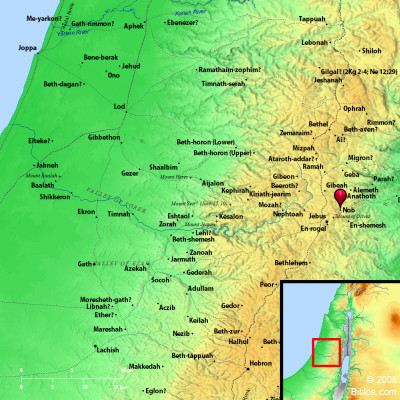Atlas  Baharum (Nob) and surrounding region Maps Created using Biblemapper 3.0 Additional data from OpenBible.info You are free to use up to 50 Biblos coprighted maps (small or large) for your website or presentation. Please credit Biblos.com. Occurrences 1 Chronicles 11:33 Azmaveth the Baharumite, Eliahba the Shaalbonite,Encyclopedia NOBnob (nobh; Codex Vaticanus Nomba; Codex Alexandrinus Noba, and other forms): An ancient priestly town to which David came on his way South when he fled from Saul at Gibeah (1 Samuel 21:1). Here he found refuge and succor with Ahimelech. This was observed by Doeg the Edomite, who informed the king, and afterward became the instrument of Saul's savage vengeance on the priests, and on all the inhabitants of the city (1 Samuel 22). The name occurs in Nehemiah 11:32 in a list of cities, immediately after Anathoth. In Isaiah's ideal account of the Assyrians' march against Jerusalem, Nob is clearly placed South of Anathoth. Here, says the prophet, the Assyrian shall shake his hand at the mount of the daughter of Zion, the hill of Jerusalem. It was a place, therefore, from which the Holy City and the temple were clearly visible. |



